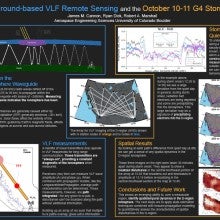Ground-based VLF Remote Sensing and the October 10-11 Geomagnetic Storm
James
Cannon
University of Colorado Boulder
Poster
The Earth’s ionosphere is classically broken into 3 distinct regions: the D-region (50-90 km), the E-region (90-150 km), and the F-region (150-500 km). Radio signals propagating through the ionosphere can, depending on frequency, become attenuated, refracted, or in the case of signals in the Very Low Frequency (VLF) range of 3-30 kHz, reflect off of the ionospheric plasma. These VLF signals also reflect off the Earth’s surface, causing efficient propagation inside the Earth-Ionosphere (EI) waveguide over thousands of kilometers. The structure of this wave propagation is dependent on the height of the D-region and, to a lesser extent, the electron density gradient within the D-region. During geomagnetically quiet days, measurements of VLF waves reveal a diurnal variation within the D-region. This is because the primary source of ionization in the D-region is solar Lyman-α radiation. However, during geomagnetically active times, the D-region density can be enhanced by X-ray flux from solar flares or by highly energetic particles from the solar wind at Auroral latitudes or precipitating from Earth’s radiation belts at mid-latitudes. The October 10-11 2024 severe geomagnetic storm (peaking at Kp=8.87, DST = -333 nT) is a perfect example of this. Data are presented of the October storm from a newly operational Array for VLF Imaging of the D-region (AVID) consisting of 11 different VLF receivers covering a mid-latitude region of ~1500 km x 2500 km spanning ~48°N to ~60°N. We show clear spatial variation within the D-region’s response to the geomagnetic storm.

Poster PDF
Poster category
Ionosphere and Thermosphere Research and Applications
Meeting homepage